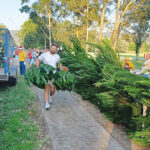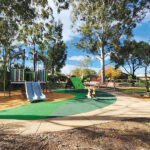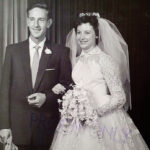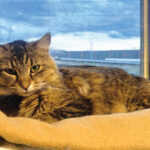Drawing of John from unknown newspaper
By Lyn Forde – President/Research Officer of St Marys & District Historical Society Inc.
JOHN Aplitt (Aplett) was born at Castlereagh in April 1852. His father and grandfather were born at Castlereagh on the Nepean River. When his father died at Penrith in 1860, his mother remarried and the family moved to the diggings at Parkes where he grew up and where he worked at gold mining, being a steady hardworking young man and very popular on the old Kurrajong and bushman’s Lead. His height rose to 5ft 10½ inches. John’s first appearance was in a pedestrian handicap foot race at Parkes in December, 1873. The winner was to get £3. He received a 3 yds start and he ran a dead heat with James Bergin a pedestrian of considerable local fame. His next appearance was in 1874 in another handicap match also at Parkes and this time there were nine competitors but he won easily. In this race he so astonished his Parkes friends that they thought him quite able to beat Gam Thompson the then crack runner at Forbes to run 200 yds for £50 aside and John won easily. In August 1874 he ran against Donald Nicholson at 150 yards, giving him 8 yds start that he also won. John’s friends thought him worthy of competing with some more famed antagonists, so they backed him to run against Charlie Baxter at 250 yards for £l00. Although he had to run against a noted runner for the first time in his life, John treated Baxter as he did his predecessors taking the lead and keeping it to the finish and beating his opponent by about nine yards. Next in December 1874 he was matched to run against David Meehan of Forbes at 150 yards for £50. On this occasion his opponent forfeited to him the first deposit of £10 and consequently the match fell through. His next match was to run against H H Manning of New Zealand, a quarter of a mile over four jumps 3ft 6in high for £25. This event took place in January 1876 at Parkes with Manning the favourite at the start, but John as before astonished even his own friends by winning. Sometime after this he was again challenged by David Meehan to run 150 yards for £100 and John accepted. The race took place at Forbes in July 1876 with John winning by about seven yards and without the slightest apparent distress. He was next challenged by Jim Watson (known as the Melbourne flyer) to run 200 yards for £100 in September 1876. Watson was favourite at first but as the day of the race drew near a greater amount of confidence was shown for John that proved was not misplaced as he again won with ease by about seven yards. John had now reached the top of the tree and his friends thought that after the many victories he had scored, he could stand alongside any man in Australia. A challenge in October 1876 was sent to Robert Watson an Irishman then considered to be the champion of Australia. The challenge was for 200 yds to race at Parkes for £300. The match took place in the presence of 1000 spectators in November, the largest number of people that had witnessed a foot race in that part of the State. Bob Watson started favourite at 5’s and 6 to 4 but although Bob (or “Scone” Watson as he was more popularly known) had never been beaten but his colours were lowered by John who beat Watson by about seven yards in 9¼ seconds. In describing the match at Parkes, it was written in the paper there that “After 13 or 14 false starts John got away with a slight advantage and it was a grand race for half the distance when John ran clean away from Bob Watson. Watson’s defeat was a great blow to his friends and supporters who believed that there was not a man in the world who could beat him”. In 1876 after his notable success again over R F Watson at Parkes, John married Frances Nicholson (who was the sister of a runner). In 1878 before a following race occurred, John made it clear to a correspondent of the Sydney Mail & NSW Advertiser that he was spelling his name wrong and it was John Aplitt not Applett the name that he was generally known in sporting circles. That return match took place at West Maitland in November 1878 of 200 yards for £500 in the locality of the Northern district of NSW where Watson was well known. R F Watson was born in Londonderry in Ireland and stood 5ft 10½ inches. On the day of the meet at West Maitland there was at least 7000 spectators and excitement ran high as to who would win. Thousands of pamphlets were sold by enterprising bookmakers’ clerks for some time previous to the race. Watson won on that occasion in a canter by two yards, this being John’s only defeat in his long and meteoric career as a pedestrian. John took part in many other matches and handicap races, the more important was a match with Ben Carver of Kurrajong in 1880 at Sandy Gallop, Clarendon near Windsor for 50 yards at £100 with John winning easily. (The area is now the aerodrome). Another match for the same amount and distance took place the same year at Fairfield, Windsor with Jack Warwick and John again winning easily. In 1880 John had many races at the Sir Joseph Banks ground at Botany. A race with Charles Carver of Moree for £100 aside at 150 yards saw John winning easily. In the same year and place John easily beat Pat Callaghan of Maitland over 150 yards for £150. Later, John and Frances took up a Merowie Hotel near Hillaton on the Lachlan, they later sold out the hotel and bought the Mount Hope Hotel, later trying to sell in 1882 but the sale elapsed. John also became a mail carrier with a lengthy connection, having around six horse teams on the roads at one time. Later in 1897 they were living at Byrock in Bourke, then Goodooga and lastly at Brewarrina where they settled down. It was said that John was one of the greatest (if the greatest) pedestrian runner in Australia. John died in November 1936 aged 84 years at a private hospital at Stanmore NSW. He had retired in 1930 and was living in Auburn with his son Donald. His remains were brought to Orange for burial as this was the fulfilment of a promise made by his family to lay his body in the Church of England cemetery beside that of Frances who died while spending a holiday in Orange in December 1933. Until that year, they had not been to Orange since they had spent their honeymoon there. He was a brilliant runner from 100 to 200 yards, a brilliant athlete and a good sportsman who outlived his contemporaries of the running tracks.
Source: Nepean Times, The Referee Sydney “Great Australian Athlete”, Australian Electoral Rolls 1903-1980, Ancestry website, Trove.






